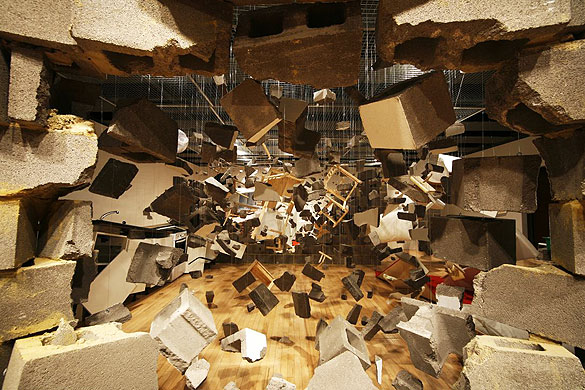Another Postcard
 After a rehearsal I chanced upon this postcard that was sat on top of the piano.
After a rehearsal I chanced upon this postcard that was sat on top of the piano.
Its from an exhibition called PsychoBuildings: Artists take on Architecture
which ran at The Hayward 28th May-25th August 2008.
The exhibition was designed as something that "plays with architectural languages and structures", and some of the work looks quite interesting i
n
terms of what it does with space.

I particularly liked the Cuban artists Los Carpinteros and their contribution, Showroom which presented a dynamic event made
stationary.

What was of particular interest to me was Rachel Whitehead's Place, which involved an arrangement of a 20 year collection of doll's houses lit from within.
My only personal experience of a Rachel Whitehead exhibition was at the Tate Modern back in 2005 with Embankment, which reminded me a lot of Superman's Fortress of Solitude. Needless to say, I liked it very much.

I first became aware of her however, in my Scenography lessons during my undergrad for her 1993 work, House. She is famous as a sculpture for inverting space and Hous
e was really an epitomy of this idea. By inverting the home itself, by making its space solid, and its solid, space, Whiteread not only challenged artistic conventions, but also challenged civic ones. The difference between this work and her previous 'casts' was that this was in the public domain.
Iain Sinclair in Lights Out For The Territory said that from the beginning, House was under sentence of death (1998: 212) and in a state of "limbo" (1998: 225). Site-specfic art had intruded into the domain of Psychogeography, a subject that encourages mobility and wayfinding. It advocates an awareness of the everchanging topography of the landscape. What House presented was something dislocated, static and multi-temporal. It was inevitable that the work would be demolished.
This is why I feel that it is slightly ironic that Whiteread's next homely themed art work returns to the gallery.
I myself am torn with this debate, when I hear of art being destroyed, (Richard Serra's Tilted Arc) I am always initially defensive. Particularly in the public environment there are obviously different amounts of red tape than with that of an exhibition in a studio or gallery. Whatever the art work is, it will always be a disruption, particularly if it is static.
But disruption does not necessarily have to have negative connotations, and obviously the disruptive qualities of art lead to provocation. But how do we deal with the political, the civic and the banal? Quite simply, we have to be temporary, we have to keep moving in order to maintain a sense of space by lacking a place (De Certeau 1998: 103).
15:03
|
Labels:
De Certeau,
House,
Place,
Psychobuildings,
Whiteread
|
Subscribe to:
Post Comments (Atom)
0 comments:
Post a Comment